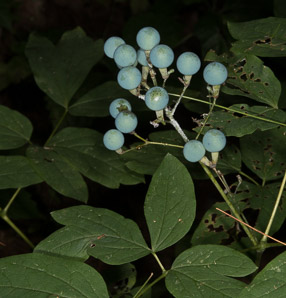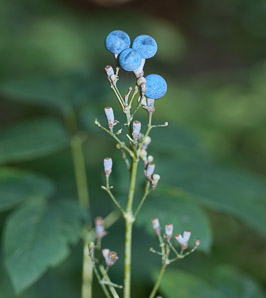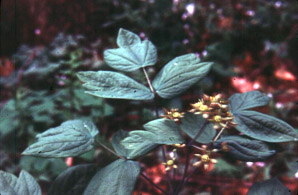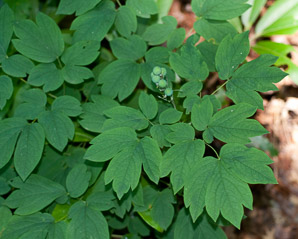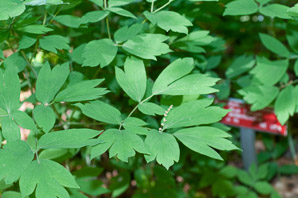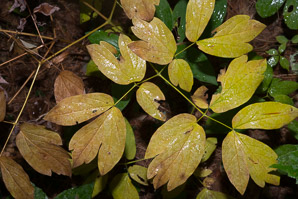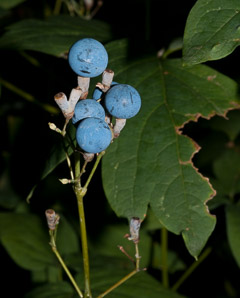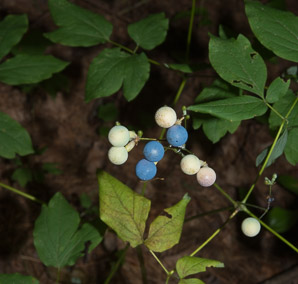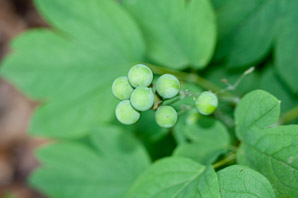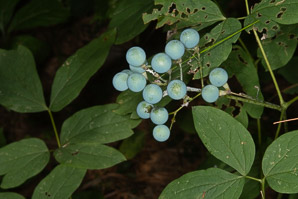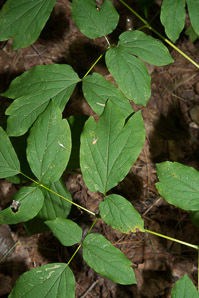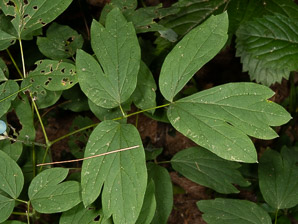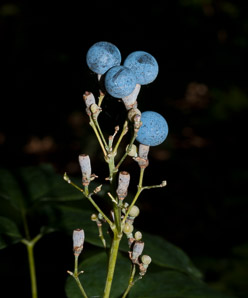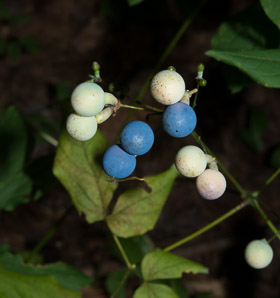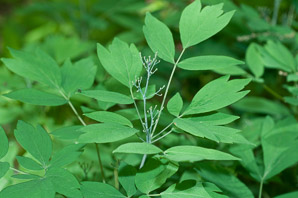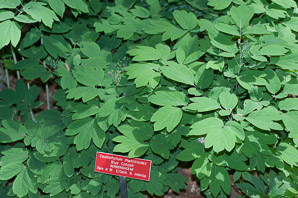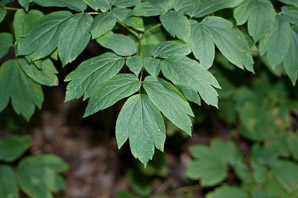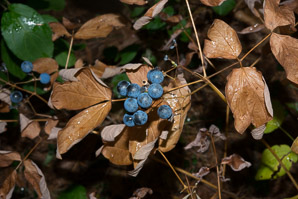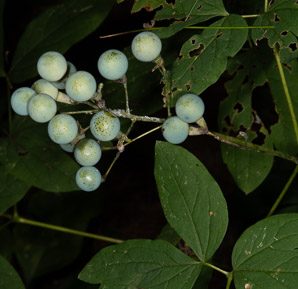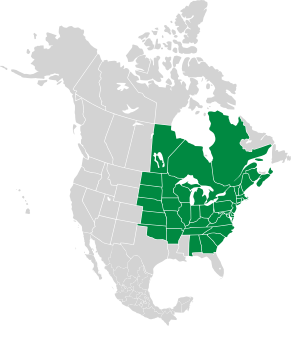
|
Caulophyllum thalictroides (L.) Michx. Blue cohosh
Blue cohosh is native to North America. What's a cohosh? A native American word for rough—a reference to the bumpy roots. See also the unrelated plant black cohosh. Widely advertised for its ability to facilitate delivery, reduce symptoms of menstrual cramps, among other things, it contains a brew of chemicals that can poison or cause miscarriage. Plants: Up to 2½′ (80 cm) tall, with several bluish-green stems. Leaves: Unusual in shape, with three (or four or five) points on the end, a little like duck feet. Each stem may have a single leaf, or a group of three, or even a group of three groups of three. Leaflets are up to 2″ (5 cm) long. Flowers: In groups (panicles) up to 1½″ (4 cm) around. Each flower is ½″ (1.3 cm) around, yellow-green or brownish-green, with six sepals that look like flower petals. Inset within the apparent flower are six smaller real petals, each with a stamen. Fruits: An attractive blue color like “blueberries covered in confectioner's sugar.” They are ⅜-¾″ (1-2 cm) in diameter, perfectly round, in clusters atop the plant. Medical: Even today, midwives often use blue cohosh to help induce labor, reflecting a practice that dates back at least as far as Native American use. However, the article Safety and Efficacy of Blue Cohosh (Caulophyllum thalictrodes) During Pregnancy and Lactation summarizes: Based on the available scientific information, blue cohosh should; 1) be used with extreme caution during pregnancy, 2) be used only under medical professional supervision and 3) not be available to the public as an over-the-counter product. There is an urgent need to conduct a retrospective or prospective cohort study of midwifes using blue cohosh in order to determine its safety. Researchers reported many dangerous side effects. It is also dangerous when taken earlier in pregnancy, as it can cause miscarriage. Edibility: Poisonous Online References:
The Connecticut Botanical Society's Connecticut wildflowers site Wildflowers of the United States 8/5/2019 · Beaver Brook Conservation Area, Wildflower Trail, Hollis, New Hampshire · ≈ 5 × 8″ (13 × 20 cm) 9/14/2010 · Garden in the Woods, Framingham, Massachusetts · ≈ 6 × 9″ (15 × 23 cm) 4/15/1979 · Memphis, Tennessee · By Tim Chandler 6/15/2010 · Garden in the Woods, Framingham, Massachusetts · ≈ 17 × 12″ (44 × 29 cm) 5/15/2010 · Garden in the Woods, Framingham, Massachusetts · ≈ 15 × 10″ (39 × 26 cm) 9/13/2015 · Beaver Brook Conservation Area, Hollis, New Hampshire · ≈ 15 × 10″ (37 × 25 cm) 9/14/2010 · Garden in the Woods, Framingham, Massachusetts · ≈ 4 × 6″ (10 × 15 cm) 8/22/2013 · Beaver Brook Assn Conservation Lands, Hollis, New Hampshire · ≈ 7 × 10″ (16 × 25 cm)
Caulophyllum thalictroides description by Thomas H. Kent, last updated 14 Aug 2021. © FloraFinder.org. All rights reserved. |
6/15/2010 · Garden in the Woods, Framingham, Massachusetts · ≈ 7 × 4½″ (17 × 11 cm) 8/5/2019 · Beaver Brook Conservation Area, Wildflower Trail, Hollis, New Hampshire · ≈ 7 × 4½″ (18 × 12 cm) 8/22/2013 · Beaver Brook Assn Conservation Lands, Hollis, New Hampshire · ≈ 7 × 11″ (18 × 28 cm) 8/5/2019 · Beaver Brook Conservation Area, Wildflower Trail, Hollis, New Hampshire · ≈ 12 × 8″ (31 × 20 cm) 9/14/2010 · Garden in the Woods, Framingham, Massachusetts · ≈ 4½ × 7″ (11 × 17 cm) 8/22/2013 · Beaver Brook Assn Conservation Lands, Hollis, New Hampshire · ≈ 5 × 8″ (12 × 19 cm) 5/15/2010 · Garden in the Woods, Framingham, Massachusetts · ≈ 12 × 8″ (31 × 20 cm) 5/22/2010 · Garden in the Woods, Framingham, Massachusetts 9/14/2010 · Garden in the Woods, Framingham, Massachusetts · ≈ 15 × 10″ (39 × 26 cm) 9/13/2015 · Beaver Brook Conservation Area, Hollis, New Hampshire · ≈ 9 × 6″ (23 × 16 cm) 8/17/2019 · Beaver Brook Conservation Area, Wildflower Trail, Hollis, New Hampshire · ≈ 7 × 4½″ (18 × 12 cm) Range: Zones 3-8:
|
